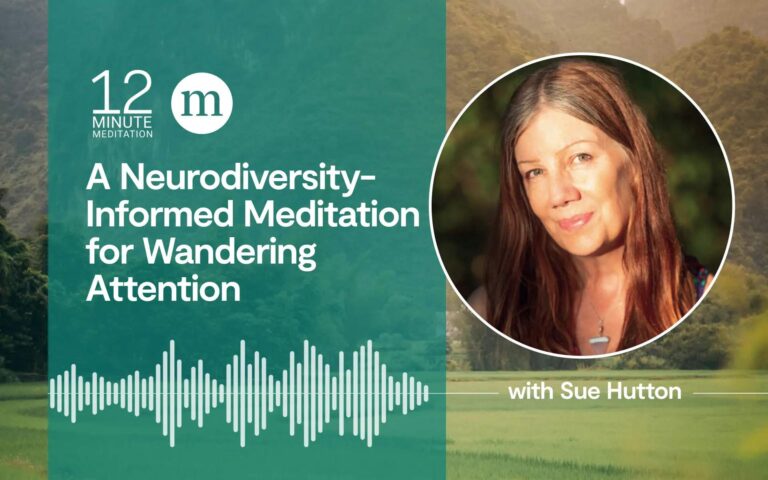In this guided session, Sue Hutton introduces a meditation method that harnesses sensory awareness to improve focus.
Many traditional meditation methods can be challenging and off-putting for those who are neurodivergent. Physical discomfort or significant mental distractions can lead even the most curious individuals to believe that conventional meditation techniques may not suit them.
Sue Hutton is committed to the idea that mindfulness should be available to everyone. She has dedicated her efforts to making practices such as meditation more inclusive for neurodiverse communities. In this session, she introduces what she calls “Dual Anchor,” a meditation technique that engages the senses to assist in gently directing attention.
Dual Anchor: A Meditation for Neurodiversity-Informed Wandering Attention
- This guided meditation, known as Dual Anchor, is designed with neurodiversity in mind. It can be exceptionally helpful for those whose minds wander a lot and find it difficult to focus. This practice combines the use of our sight and breath to anchor our attention effectively.
- Often, we hold a lot of tension in our bodies, and we want to avoid worsening that during our meditation. When we meditate, we aim to nurture a sense of calm within. I encourage you to approach this practice with compassion for yourself, accompanied by gentle curiosity. Try your best, but if anything feels overwhelming, remember it’s okay to take a step back.
- Let’s begin by focusing your vision on an object before you. A candle can be a great focal point, especially the tip of the flame, but feel free to choose any object that piques your interest. Sit up straight and give your full visual attention to this object.
- Focus intently on the center of that object. As you do this, notice how your body relaxes. Imagine how a film director zooms in; you should concentrate very clearly on the object and allow your mind to sharpen, letting everything else fade into the background.
- Relax your brow and jaw. Keep your body loose as you closely observe this object. Can you sense its color, texture, and shape? Just watch intently. Your gaze is now highly focused.
- Now, let’s add breath awareness. To start, close your eyes for a moment while you tune into your breath. Softly let your eyelids rest on your eyes, like gentle blankets, creating a calm space within.
- Now, feel the flow of your breath however feels right to you. You might notice the sounds of your breath, breathing in with a loudness comparable to ocean waves, or simply feel the gentle rise and fall of your body as you breathe. You can place a hand on your belly and chest to feel this movement or tune into the sensation of breathing from inside your body.
- Throughout this exercise, maintain a deep sense of compassion and love for yourself. You might even feel warmth flowing into your body through your hands, offering yourself a loving touch as you breathe in and out. Remember, each exhale is an opportunity to allow yourself to relax further. This is a space for you to cultivate calmness.
- Open your eyes again and concentrate on that object, combining your focus on vision and breathing. Maintain unwavering attention on this object, allowing your concentration to sharpen, and keep your brow and jaw relaxed.
- Now, link the rhythm of your breath to this focus. Feel yourself at the center of this concentrated experience, with clear vision and an unwavering connection to your breath, creating an inner calm.
- As you find this compassionate rhythm using focused attention on your breath and vision, let each exhale release even more tension. What else can you relax on the next exhalation?
- There’s clarity in concentrating on these two points simultaneously. See if you can dedicate a little more commitment to maintaining your focus on both your breath and your vision, allowing a deeper relaxation to flow through your body from head to toe.
- You can now close your eyes once more, staying connected to your breath. With your eyes closed, allow your face to soften. You may notice that it’s not completely dark behind closed eyelids; you could see shapes or light, offering further relaxation as you sink into a compassionate breathing rhythm.
- If you feel comfortable, gently open your eyes. Take a moment to look around the room, observing different objects. Engage with your surroundings, noticing textures, colors, and shapes. A simple word to name the object can be helpful—keep it to one word, no descriptions.
- This concludes our dual anchor meditation practice for today using vision and breath. You can return to this practice anytime throughout your day. For more similar practices, visit my website at SueHuttonMindfulness.com where you can explore other mindfulness techniques that cater to neurodiversity. May you discover many unique ways to integrate mindfulness into your life. Thank you for meditating with me.


